
When I am present at loading operations and observe the processes, I am always amazed at the damage to the truck that is accepted without a word by the loading employee or the loading company and the truck is loaded. Damage, even if it is not insignificant, is accepted like a summer storm against which nothing can be done.

This means that there is a risk that the truck will be stopped, checked and, if necessary, immobilized as part of a routine inspection. The fulfillment of the supply agreement with the customer is thus called into question.
How does this behavior come about, what could be the causes and how can/must such situations be avoided?
One of the main causes seems to me to be the fact that knowledge about costs, value and equivalent value is not available or is distributed among different people. Perhaps an example that many people can relate to:
You go to the supermarket to do your shopping and need, among other things, 500 g of canned beans. The price is stated with the goods or on the packaging and is acceptable. One of the tins has a slightly damaged band and the metal has a slight dent. The contents are certainly undamaged. However, everyone opts for an undamaged can because they are entitled to a flawless product.
When transporting goods by truck, it is basically the same, but the way of thinking is not consistently implemented because there are several parties involved.
Transport prices are negotiated and it is often not clear to the parties involved what they are delivering for the agreed price, or what they are supposed to get. This is exactly the crux of the matter. A means of transportation must meet the following requirements:
Only when points 1-3 have been clarified clearly and in detail can the most favorable provider be selected.
The following collection of images is intended to show examples of what defects that play a role in point 2 can look like.

Massive damage to the load-bearing frame of the cargo bed.
>> Reject loading.
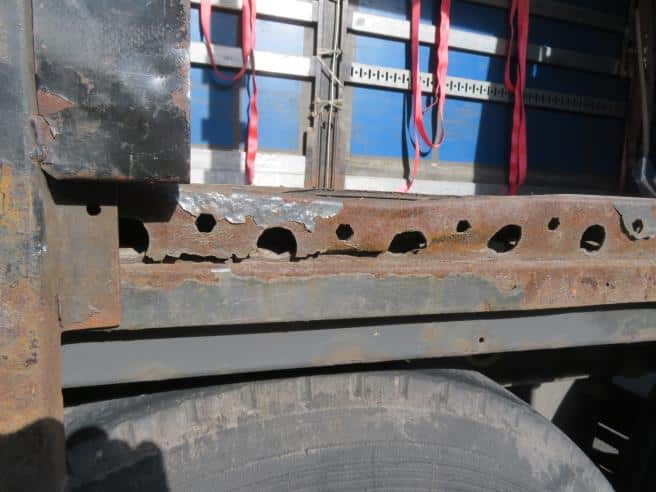
Perforated strip rusted through and away. It is no longer possible to attach tension belts.
>> Reject loading.
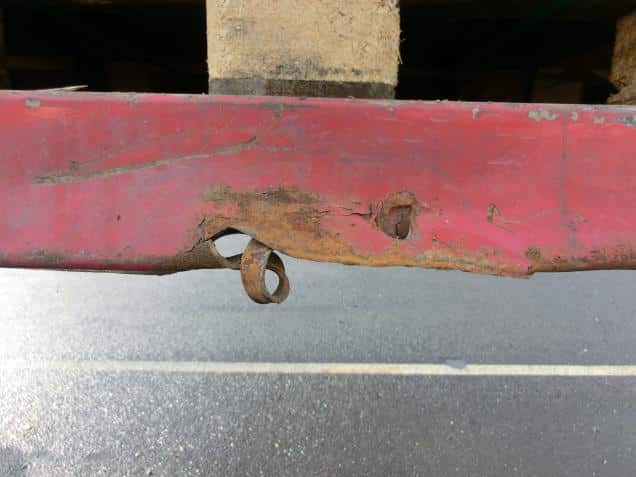
Damaged frame of the cargo bed, a load-bearing part.
>> Reject loading.
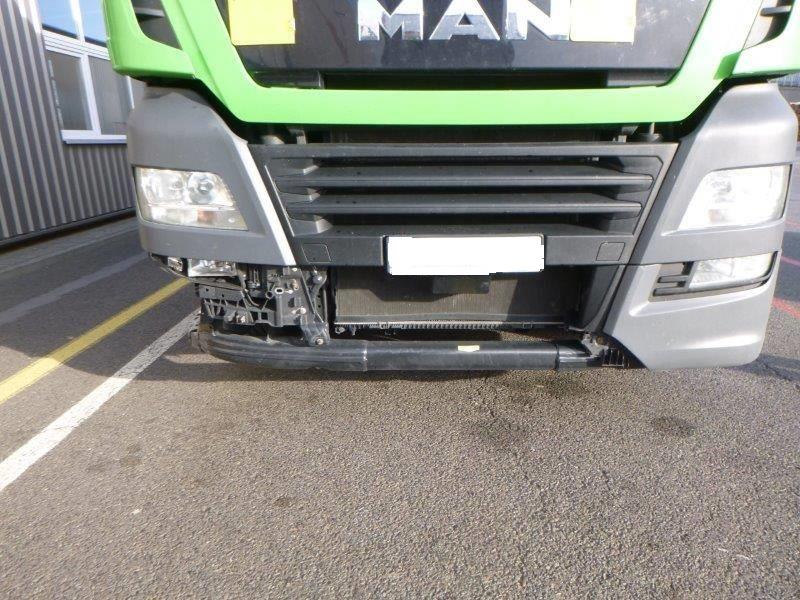
Damage to the lighting system and thus an impairment of operational and road safety.
>> Reject loading.
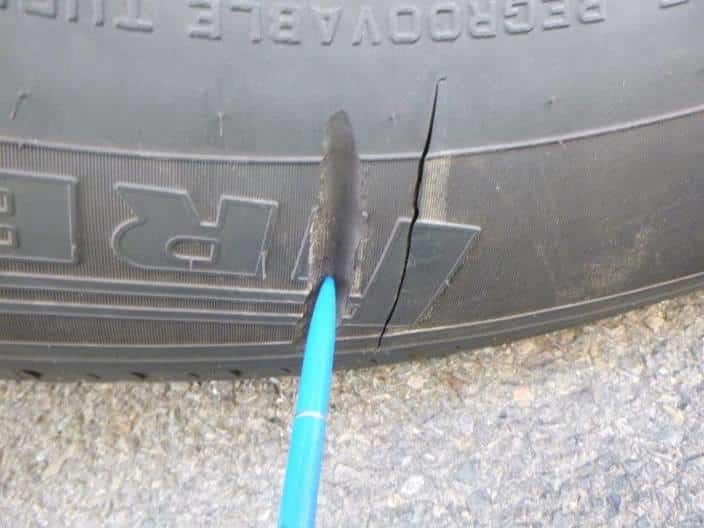
A damaged tire impairs operational and road safety.
>> Reject loading.

The damage is so extensive that the fabric of the tire can already be seen.
>> Reject loading.
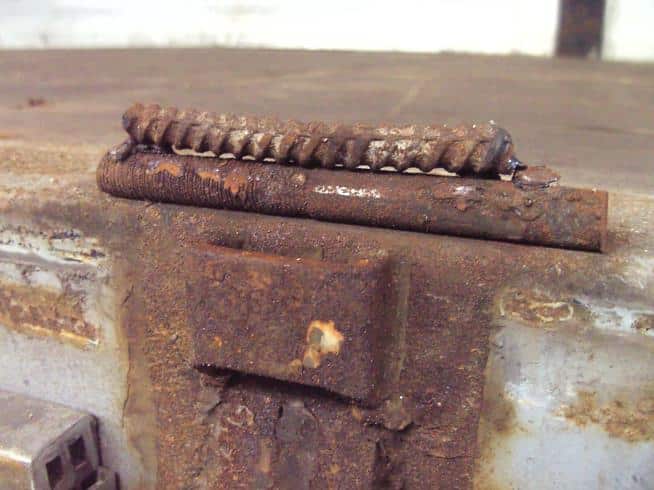
Structural modifications to the loading area frame. Depending on the impression given by the overall vehicle, loading should be rejected. Experience has shown that other damage is also present.
>> Depending on the overall situation, refusing would be the cleanest solution.

Dropside hinges replaced by a self-made hinge. The strength of the dropside is therefore no longer comprehensible. Form-fit stowage is no longer sufficiently secure. It would be conceivable to secure the load with straps (tie-down/direct lashing).
>> Depending on the overall situation, refusing would be the cleanest solution.


Structural modifications to the loading area frame. Depending on the impression given by the overall vehicle, loading should be rejected. Experience has shown that other damage is also present.
>> Depending on the overall situation, refusing would be the cleanest solution.
The pictures above show that you don’t have to look for obvious defects, they catch the eye. A walk around the vehicle is usually sufficient to recognize them. The decisive factor is that the subsequent action and the necessary consequences are clearly and unambiguously regulated.
Unfortunately, experience also shows that some transport companies only understand the “hard way” and only react to a rejection. The shipping company should always act in such a way that it is on legally secure ground.
Yours, Sigurd Ehringer
<< To the previous post
Episode 29: Discard maturity of lashing straps – The criteria
To the next post >>
Episode 31: Reefer – Refrigerated container: Structure and loading

Tobias Kreft
Rothschenk assortment
Our customer center has only one goal: to turn your problems into solutions. Whether standard stowage cushions, bestsellers or load securing personally tailored to your needs -. we accompany you consistently from A as in field service to Z as in certification. That is our promise to you, as a leader in our industry.
We attach great importance to professional cargo securing. That is why we have our own production, which ensures reliable operation through modern manufacturing technologies and strict quality control. Thus, we offer our customers a comprehensive and high-quality range of services in the field of transport logistics.
DIN ISO 9001:2015, EMAS and Ecovadis are not foreign words to you? Then it's time to work with the best.
You don't take any risks with us - we have been awarded the Platinum Medal on the EcoVadis sustainability rating platform.
As a load securement company, we are proud to have several certifications that validate our sustainability efforts and our commitment to environmental protection and social responsibility. For you as a purchaser, this means that we demand and promote the implementation of high environmental and social standards both within the company and along the supply chain.
G&H GmbH Rothschenk
Industriestrasse 5 & 7-10
97239 Aub
Phone: +49 9335 97 15 – 79
Fax: +49 9335 97 15 – 15
E-mail: info@rothschenk.de
Collection/delivery
Mon – Fri: 8:00 – 15:00
Office hours
Mon – Thu: 8:00 – 17:00
Fri: 8:00 am – 1:00 pm
G&H GmbH Rothschenk
Industriestrasse 5 & 7-10
97239 Aub
Phone: +49 9335 97 15 – 79
Fax: +49 9335 97 15 – 15
E-mail: info@rothschenk.de
Collection/delivery
Mon – Fri: 8:00 – 15:00
Office hours
Mon – Thu: 8:00 – 17:00
Fri: 8:00 am – 1:00 pm